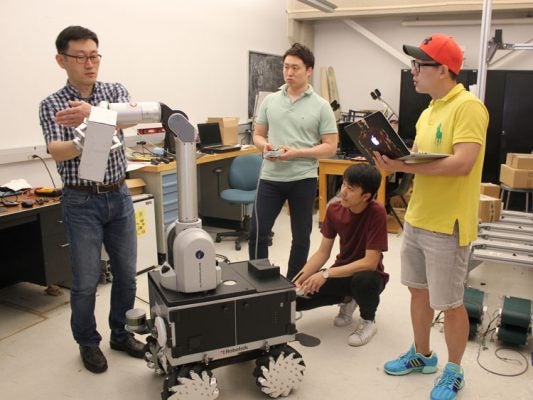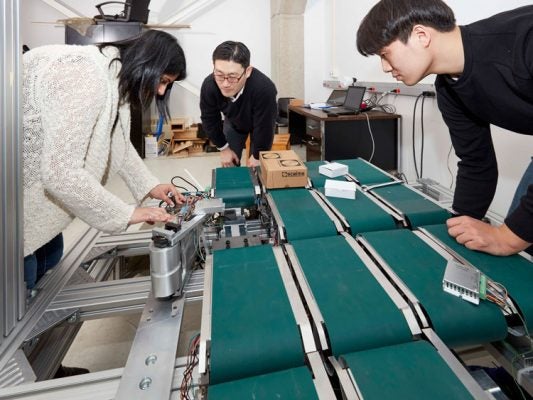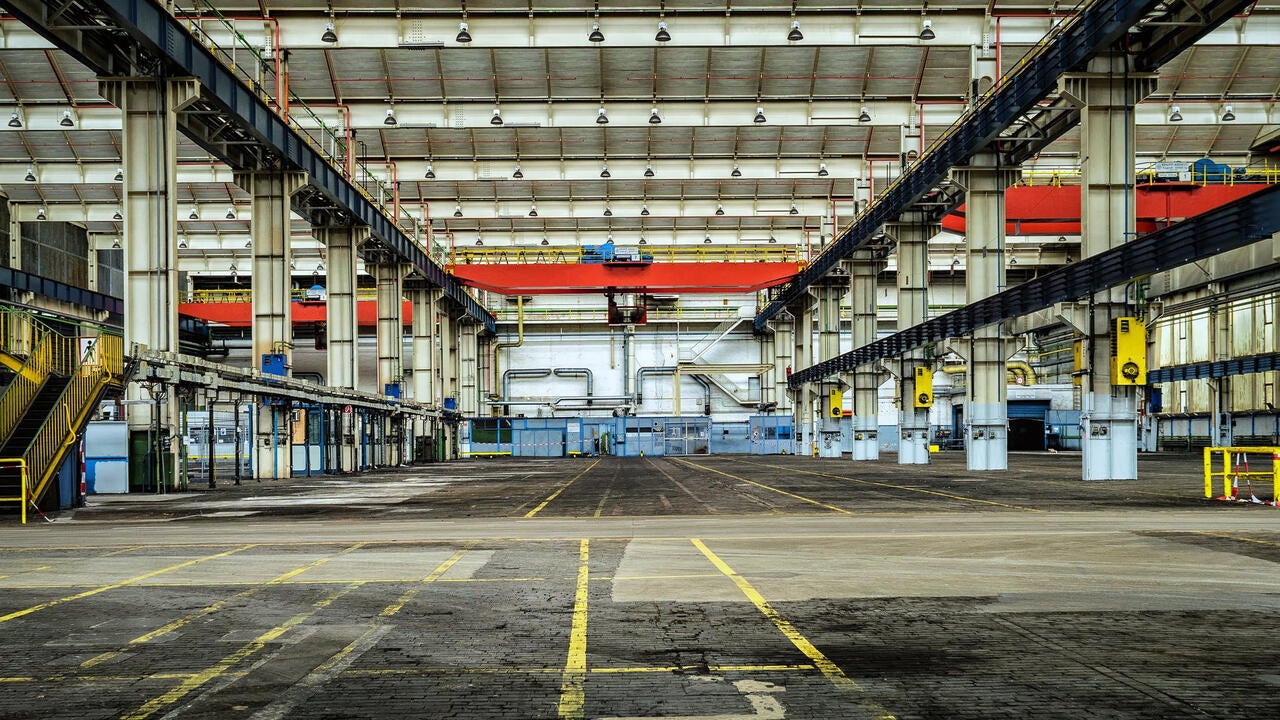A robot glides across a warehouse floor, picks up an object from a top shelf, boxes it and then carefully loads the wrapped package on a delivery truck – all in record time and without bumping into anything.

Soo Jeon and his team of Waterloo Engineering researchers are working on technology to perfect this type of robotic employee that would automate fulfillment centre practices, save money and reduce on-the-job accidents.
As ecommerce companies such as Amazon continue to grow rapidly, so too do their warehouses and the number of people working in them, points out Jeon, a Waterloo mechanical and mechatronics engineering professor.
“The goal is to reduce the everyday physically demanding tasks performed by humans in warehouses,” says Jeon. “Human workers would then be able to move into higher-level task positions.”
Backed by funding from the Natural Sciences and Engineering Research Council of Canada’s (NSERC) Strategic Partnership Grant, Jeon is the principal investigator of the new three-year research project with Canadian courier company Purolator.
Along with Waterloo Engineering professors and robotic experts William Melek and Dana Kulić, Jeon is leading a team to develop a robotic companion that has the type of human-like dexterity to pick up different sized and weighted objects from various heights and then navigate autonomously through a warehouse without colliding with people, forklifts and fixed objects.
This past spring, Jeon was awarded funding through the NSERC’s Research Tools and Instruments Grants Program to purchase an additional wrist module with all the sensing capabilities required to build a fully dexterous robotic arm. The dexterous robotic arm will be integrated into a heavy-duty mobile platform, which recently arrived from Europe where it was produced.
Optimizing package delivery
Jeon is also working on technology for the robotic companion that would optimize how packages are delivered in large areas such as shopping malls.
Currently, Purolator employees often deliver packages to malls after hours when stores are closed. Without consumers filling the space, employees are able to make their deliveries relatively easily, but they often take multiple trips since many aren’t able to carry everything at once.
The robotic companion would not only be able to carry dozens of packages at the same time, but could advise the human delivery person on the optimal route to take from store to store. This would result in a substantial reduction in time spent at each mall and, perhaps more importantly, reduce the amount of physical labour required.
“Common complaints from workers are that their jobs are too physically demanding and they need to work very late into the night,” says Jeon. “The labour market is aging and the average age of employees is rising which is a serious problem. But with a robotic companion even seniors should be able to continue working.”
Also involved in the project is Avidbots, a startup cofounded by Pablo Molina and Faizan Sheikh, both Waterloo mechatronics engineering alumni and Jeon’s former students. Avidbots has developed Neo, an industrial floor-scrubbing robot that requires good navigation technology.
“Avidbots’ main goal is to enable its robotic scrubber to perform at the human driver level,” says Jeon. “That aligns very well with our project.”
Strong robotics background
While pursuing his doctoral degree at the University of California at Berkeley, Jeon worked with a robot manufacturing company in Japan. His research focused on how to improve the motion control of industrial robots with motion sensors and visual cameras.
Since joining the University of Waterloo in 2009, Jeon has worked on smart instrumentation and control for various mechanical systems. It was Jeon’s expertise on intelligent sensors and sensing systems that initially caught the interest of Purolator in 2014. The company contacted him at that time to see if he was interested in helping the company automate part of its parcel sorting process to make it more efficient.
During the past four years, Jeon and his research team have been developing a section of the company’s conveyor belt to help determine the accurate cost of shipping. The amount charged for shipping is based on size and weight, but currently only the size of each package can be measured while moving through a laser.
 “You have to stop the conveyor and separate the boxes to weigh each one and then put them back on,” says Jeon. “Purolator felt that by not getting the accurate weight they were losing some revenue. It’s also not good for the transporting vehicles and airplanes because there’s a maximum weight they can load.”
“You have to stop the conveyor and separate the boxes to weigh each one and then put them back on,” says Jeon. “Purolator felt that by not getting the accurate weight they were losing some revenue. It’s also not good for the transporting vehicles and airplanes because there’s a maximum weight they can load.”
To solve the problem, Jeon and his research team came up with the idea of dividing the conveyor belt into sections with each cell acting as a weigh scale and a mini conveyor.
“We packaged everything into one small system – the load cell, the motor, the small roller with a camera on top,” says Jeon.
By taking a real time measurement of the location and orientation of each box it’s possible to calculate what load the cells are supporting and the exact weight. Jeon’s students are currently developing an algorithm to separate each box and determine accurate pricing.
Encouraged by the success of his research team’s first collaboration with Purolator, Jeon put forward a proposal to the company last year to use robotics technology for logistics and warehousing.
Waterloo Engineering reputation is spreading
Jeon says Waterloo Engineering is a great place to do research because of the strength of its researchers and students. And word is quickly spreading around the world about the reputation of the school. While on sabbatical in Korea last year, Jeon discovered many more people knew about the Faculty compared to the last time he was in his native country.
“People were interested in finding out more about our co-op program and why our students are so strong and well positioned to get good jobs,” he says. “It’s the real-world experience they receive. Our students are very hands-on, very disciplined and very professional.”


 “You have to stop the conveyor and separate the boxes to weigh each one and then put them back on,” says Jeon. “Purolator felt that by not getting the accurate weight they were losing some revenue. It’s also not good for the transporting vehicles and airplanes because there’s a maximum weight they can load.”
“You have to stop the conveyor and separate the boxes to weigh each one and then put them back on,” says Jeon. “Purolator felt that by not getting the accurate weight they were losing some revenue. It’s also not good for the transporting vehicles and airplanes because there’s a maximum weight they can load.”






